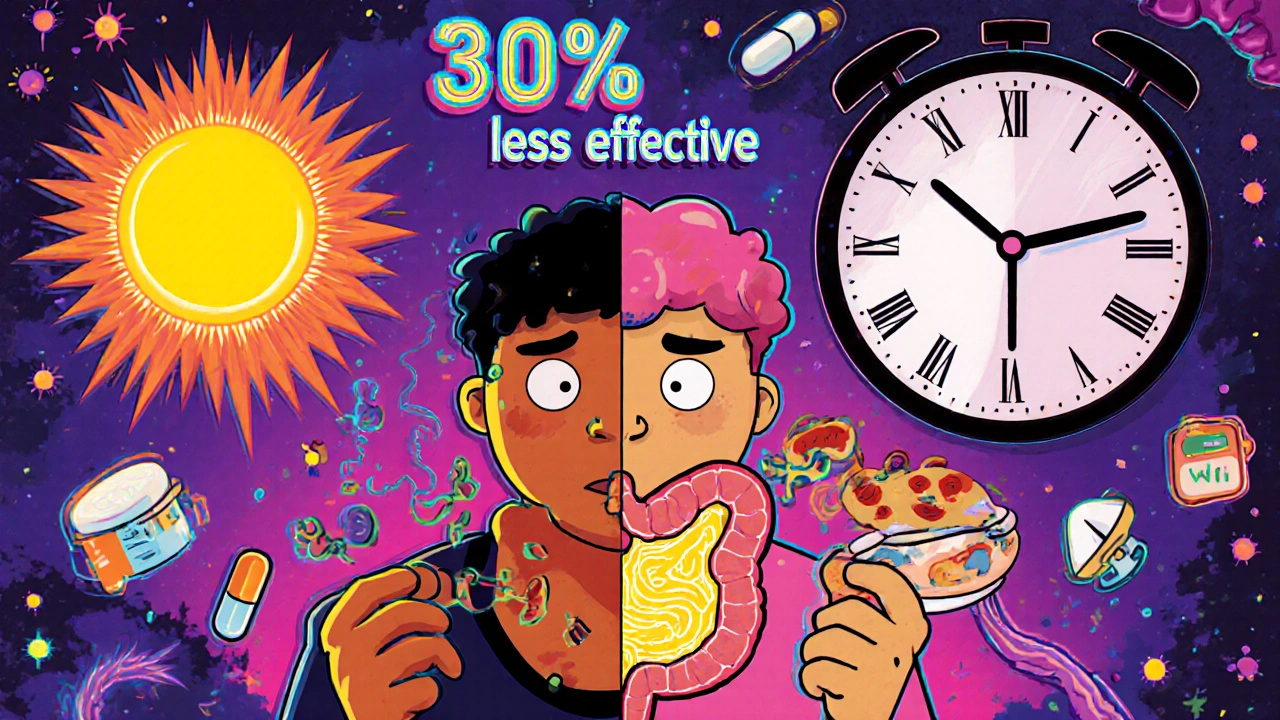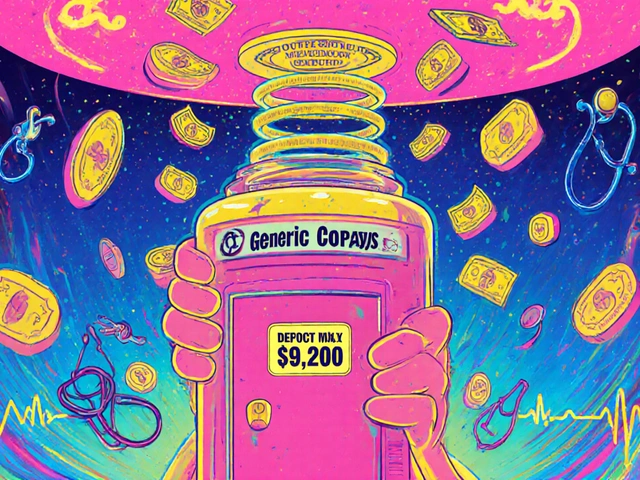Immunosuppressant Drug Interaction Checker
Check for Dangerous Interactions
Enter your immunosuppressant and other medications to see potential risks.
When you’re on immunosuppressants after a transplant or for an autoimmune disease, the goal is simple: keep your immune system from attacking your new organ or your own body. But here’s the catch-these drugs don’t work in isolation. Azathioprine and mycophenolate mofetil (MMF) are two of the most common drugs used for this, and mixing them with other medications can be dangerous if you don’t know what you’re doing.
How Azathioprine and Mycophenolate Work
Azathioprine and mycophenolate both stop your immune cells from multiplying, but they do it in completely different ways. Azathioprine breaks down into 6-mercaptopurine, which then gets turned into toxic compounds that mess with DNA building in immune cells. It’s an old drug-approved in 1968-and still used in about 15% of transplant patients today.
Mycophenolate, on the other hand, blocks a specific enzyme called IMPDH that immune cells need to make purines-the building blocks of DNA and RNA. Without purines, those cells can’t multiply fast enough to cause damage. It’s more targeted, which is why it’s now the go-to for 70% of kidney transplant patients. It also works better for autoimmune conditions like lupus nephritis and autoimmune hepatitis.
One big difference? Azathioprine needs a genetic test before you even start taking it. About 1 in 10 people have a version of the TPMT gene that makes them process the drug too slowly. If you’re one of them and you take a normal dose, your white blood cell count can crash-sometimes within weeks. That’s why doctors check your TPMT status first. Mycophenolate doesn’t need that test, but it has its own set of rules.
Key Drug Interactions You Can’t Ignore
Here’s where things get risky. Azathioprine and mycophenolate don’t play well with a lot of other common drugs.
Allopurinol and azathioprine-this combo is a red flag. Allopurinol, used for gout, shuts down the enzyme that normally breaks down azathioprine. That means your body ends up with up to 6.3 times more active drug than it should. The result? Severe, life-threatening bone marrow suppression. The FDA gives this interaction a black box warning-the strongest possible. If you’re on azathioprine and need gout treatment, your doctor must cut your azathioprine dose by 75% or switch you to something else entirely.
Proton pump inhibitors (PPIs) like omeprazole or pantoprazole are another problem, especially with mycophenolate. These stomach acid reducers can drop mycophenolate’s absorption by 25-35%. That’s not just a minor dip-it can lead to rejection in transplant patients or flare-ups in lupus. If you’re on mycophenolate and need acid control, your doctor might switch you to an H2 blocker like famotidine, or increase your mycophenolate dose. Some patients even switch to the enteric-coated version (EC-MPS), which is less affected by stomach pH.
Cyclosporine and tacrolimus-these are calcineurin inhibitors, the other major class of transplant drugs. Cyclosporine reduces the amount of active mycophenolate in your blood by 35-50% because it interferes with how the drug gets recycled in your gut. If you switch from cyclosporine to tacrolimus, your mycophenolate levels can suddenly spike. That’s why doctors always check your mycophenolate blood levels (MPA AUC) when switching between these drugs. Many transplant centers now use therapeutic drug monitoring for mycophenolate-targeting 30-60 mg·h/L-to avoid under- or overdosing.
Side Effects and Real-Life Challenges
Both drugs cause side effects, but they’re very different.
Azathioprine users often report sun sensitivity. One patient in Perth told me they got severe burns on their arms just from walking to the mailbox. That’s because azathioprine increases skin cancer risk-about 1.8 times higher than mycophenolate. Long-term users need regular skin checks.
Mycophenolate’s biggest issue? Gut trouble. Up to 40% of people get diarrhea, nausea, or vomiting. It’s so common that many patients try three or four different formulations before finding one they can tolerate. The enteric-coated version (Myfortic) cuts GI side effects by 30%, which is why it’s become the preferred choice for many.
And here’s something most patients don’t know: mycophenolate’s effectiveness drops if you take it with food or antacids. You’re supposed to take it on an empty stomach-one hour before or two hours after meals. But life isn’t that neat. If you’re rushing out the door or eating breakfast with your kids, it’s easy to forget. That’s why adherence drops. One study found 82% of people took mycophenolate correctly at 12 months, compared to 76% for azathioprine. Cost plays a role too-azathioprine costs $25 a month; mycophenolate can hit $600.

Who Gets Which Drug?
It’s not just about what works best-it’s about who you are.
If you’re young, have lupus nephritis, or need strong immunosuppression without the cancer risk, mycophenolate is the clear winner. In the ALMS trial, it led to complete kidney remission in 56% of patients, compared to 42% with azathioprine.
If you’re older, have inflammatory bowel disease, or live in a place where $600/month isn’t an option, azathioprine still has value. It’s the only immunosuppressant proven to work well in Crohn’s disease-mycophenolate only helps about 35% of those patients.
And for autoimmune hepatitis? A Dutch study showed mycophenolate led to remission in 72% of patients, while azathioprine only hit 50%. That’s why many hepatologists now start with mycophenolate unless there’s a reason not to.
What About Taking Them Together?
Some doctors still use both drugs at the same time, especially in high-risk transplant cases. But the evidence is mixed. DrugBank warns of increased toxicity. Yet, a 2020 European study found that when patients failed azathioprine first and then switched to mycophenolate, 87% didn’t have worse side effects. So it’s not the combo itself-it’s how and when you use it.
Most experts agree: don’t start both at once. Use one first. If it doesn’t work or causes side effects, switch to the other. Never combine them without close monitoring.

Monitoring and Practical Tips
Here’s what you need to track:
- Azathioprine: Get a TPMT test before starting. Check your blood counts every 1-2 weeks for the first month, then monthly. Watch for signs of infection or unusual bruising.
- Mycophenolate: Take it on an empty stomach. Avoid antacids and PPIs unless absolutely necessary. If you’re on cyclosporine, your doctor should check your MPA blood levels. If you’re on tacrolimus, expect a possible dose increase.
- Both: Avoid live vaccines. Get flu shots and pneumonia vaccines, but skip things like the nasal flu spray or shingles vaccine (Zostavax).
If you’re on mycophenolate and get diarrhea, don’t just reach for loperamide. Talk to your pharmacist. Sometimes switching to EC-MPS or adjusting the timing helps more than medication.
If you’re on azathioprine and start feeling sunburned after minimal exposure, protect your skin. Wear UPF 50+ clothing, use zinc oxide sunscreen, and get annual skin checks.
The Future: Personalized Dosing and New Options
The field is moving fast. In 2022, the FDA approved a TPMT genotype-guided dosing calculator that’s already cut severe side effects by 37% in hospitals that use it. Mycophenolate is getting better too-new delayed-release tablets launched in 2023 reduce GI side effects by 28%.
But for now, azathioprine and mycophenolate remain the backbone of immunosuppression. New drugs like voclosporin are coming, but they’re expensive and not yet proven for all conditions. The real advantage of these two? They’re generic, they’ve been studied for decades, and we know how to use them safely-if we pay attention to the interactions.
If you’re taking either drug, keep a list of everything else you’re on-prescriptions, OTC meds, supplements, even herbal teas. Bring it to every appointment. A simple interaction can turn a stable transplant into a hospital trip.
Can I take azathioprine and mycophenolate together?
Most doctors avoid combining them unless absolutely necessary. While some studies show it’s safe when used sequentially (azathioprine first, then mycophenolate), taking them together increases the risk of bone marrow suppression and infection. If your doctor recommends it, you’ll need frequent blood tests and close monitoring.
Why do I need to take mycophenolate on an empty stomach?
Food, especially high-fat meals, and antacids can reduce how much of the drug your body absorbs-by up to 25%. That means less drug in your bloodstream, which raises your risk of organ rejection or disease flare. Taking it one hour before or two hours after meals ensures you get the full dose.
Is mycophenolate better than azathioprine for lupus?
Yes, for most people with lupus nephritis. In the ALMS trial, mycophenolate led to complete kidney remission in 56% of patients compared to 42% with azathioprine. It also has a lower risk of long-term cancer and bone marrow damage. Many rheumatologists now make it the first-line choice unless cost or GI side effects are major concerns.
What happens if I miss a dose of mycophenolate?
If you miss a dose, take it as soon as you remember-if it’s within a few hours. Don’t double up. Missing doses increases your risk of rejection or disease flare. If you frequently forget, talk to your pharmacist about pill organizers, alarms, or switching to once-daily formulations like EC-MPS.
Can I drink alcohol while on azathioprine or mycophenolate?
Moderate alcohol is usually okay, but heavy drinking increases liver stress and can worsen side effects like nausea and low blood counts. Since both drugs are processed by the liver, alcohol adds extra strain. Most doctors recommend limiting alcohol to 1-2 drinks per week, if at all.
Do I need blood tests while on these drugs?
Yes. For azathioprine, you need a TPMT test before starting and regular blood counts (CBC) every 1-2 weeks for the first month, then monthly. For mycophenolate, blood counts are checked monthly, and if you’re on cyclosporine or have kidney problems, your doctor may order MPA blood level tests to ensure you’re getting the right dose.
Why is azathioprine still used if mycophenolate is better?
Cost and specific conditions. Azathioprine costs about $25 a month; mycophenolate can be $600. It’s also the only immunosuppressant proven effective for inflammatory bowel disease like Crohn’s, where mycophenolate works in only 35% of cases. In places with limited resources, azathioprine remains essential.
What should I do if I start feeling sick while on these drugs?
Don’t wait. If you have fever, sore throat, unexplained bruising, dark urine, severe diarrhea, or a new rash, contact your transplant team or rheumatologist immediately. These could be signs of infection, low blood counts, or liver toxicity-all treatable if caught early.







Jennifer Walton
November 15, 2025 AT 17:14Interesting breakdown. I’ve been on mycophenolate for 4 years. The GI issues are real-but switching to Myfortic changed everything. No more noon vomit sessions. Just take it before breakfast, and you’re golden.
Kihya Beitz
November 17, 2025 AT 08:12So let me get this straight-we’re paying $600 a month for a drug that makes you puke, but $25 for one that might give you cancer? Thanks capitalism. 🤡
Ryan Airey
November 17, 2025 AT 14:18Anyone who takes mycophenolate with food deserves what they get. This isn’t a suggestion-it’s a medical imperative. If you can’t follow basic instructions, don’t blame the drug.
Hollis Hollywood
November 18, 2025 AT 20:57I’ve been on azathioprine since 2018, and honestly? The sun sensitivity thing caught me off guard. I thought I was just getting older until I got a basal cell carcinoma on my nose. Now I wear a hat indoors. I’m not joking. Your skin forgets it’s not in the tropics. Just… be careful. The doctors don’t always warn you about the little things.
Andrew Eppich
November 20, 2025 AT 11:24It is concerning how many patients treat immunosuppressants like over-the-counter supplements. The responsibility lies with the individual to educate themselves. If you are taking these medications, you are no longer a casual participant in your own health-you are a steward of a fragile biological system.
Jessica Chambers
November 22, 2025 AT 08:08My pharmacist told me to take my mycophenolate with a glass of water and then wait an hour before eating. I started doing it with my coffee. Now I don’t feel like I’m gonna puke my guts out. 🤞
Shyamal Spadoni
November 22, 2025 AT 21:05They say TPMT testing is standard but I bet 80% of clinics skip it to save money. I know a guy in Mumbai who got his WBC crash after 3 weeks. They didn’t test him. Who’s really in charge here? Pharma? The system? The FDA? It’s all smoke and mirrors. And they wonder why people distrust medicine.
Ogonna Igbo
November 24, 2025 AT 13:54In Nigeria we don't even have these drugs properly. My cousin took azathioprine from a street vendor and died. You talk about interactions like it's a luxury problem. We fight just to get the bottle. Don't lecture us about empty stomachs when you don't even have food to eat with it.
BABA SABKA
November 25, 2025 AT 22:13Let’s be real-mycophenolate’s GI side effects are a marketing ploy. The real issue is the gut microbiome collapse from chronic immunosuppression. We need probiotic protocols, not just ‘take it on an empty stomach.’ That’s band-aid medicine. We’re treating symptoms, not root causes. The system is broken.
Chris Bryan
November 27, 2025 AT 02:34They’re pushing mycophenolate because it’s patented. Azathioprine’s been around since the 60s-cheap, proven, and safe if you test TPMT. But Big Pharma doesn’t profit from generics. So they gaslight patients into thinking the old drug is dangerous. Wake up.
Jonathan Dobey
November 28, 2025 AT 06:10It’s not about azathioprine vs. mycophenolate-it’s about the illusion of control. We think we’re managing disease, but we’re just delaying the inevitable entropy of the immune system. These drugs are digital bandaids on a leaking dam. We’re playing God with purine pathways and calling it science. The real question: who gave us the right to rewrite biology?
ASHISH TURAN
November 29, 2025 AT 11:37My dad switched from azathioprine to mycophenolate after his liver flare. He had diarrhea for 3 months. Then they switched him to EC-MPS. He’s been stable for 2 years. Just because one drug doesn’t work doesn’t mean you’re out of options. Talk to your pharmacist. They know more than you think.
Aidan McCord-Amasis
December 1, 2025 AT 10:38Allopurinol + azathioprine = death sentence. 💀 Don’t be that guy. Get your TPMT tested. Or just don’t take the combo. Simple.
Adam Dille
December 2, 2025 AT 02:27My transplant nurse gave me a little alarm clock that goes off twice a day. I set it for before breakfast and before bed. I don’t always get it perfect, but I’m way better than I was. Also, I started using a pill box with days of the week. Game changer. 🙌